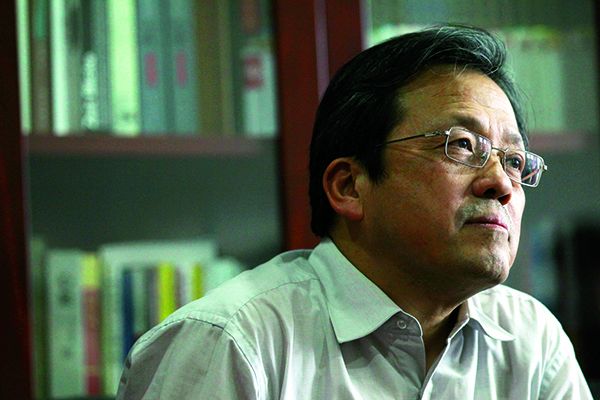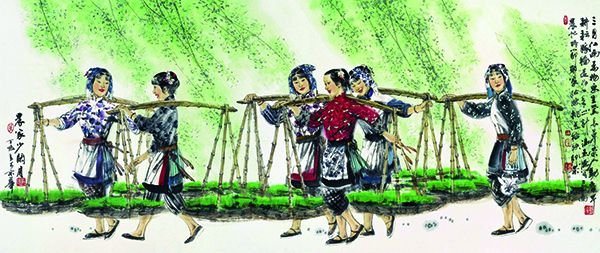
 |
|
Feng Yuan believes Chinese ink art still has its distinctive value and should win a wider audience. Zou Hong / China Daily |
 |
|
An ink painting by Feng Yuan features women farmers. |
As China's influence continues to grow globally, so should its ink paintings and artists, says Feng Yuan, vice-chairman of the China Federation of Literary and Art Circles.
"I believe Chinese ink art still has its distinctive value, artistically and socially," says the 60-year-old, whose first solo show ended recently at the National Art Museum of China.
"It is time for Chinese ink artists to reach out and win a wider audience with creative works that truly reflect social reality."
After its Beijing debut, the solo show is expected to tour Jiangsu's provincial capital Nanjing, Zhejiang's provincial capital Hangzhou and Shanghai.
The exhibition "creates a fleshy portrait of Feng's three-decade career, with about 1,400 ink figure paintings, landscapes, and abstract and calligraphic works, rendered in evolving styles", National Art Museum of China director Fan Di'an says.
Feng says Chinese ink paintings boast of a long and glorious history, and has made unprecedented advancement over the past few decades, especially in terms of styles and techniques.
But many people still view Chinese ink art as outdated, conservative and irrelevant, and confined to intelligentsia and a handful of collectors.
It has been excluded from so-called contemporary Chinese art, which includes oil painting, prints, video art, sculptures and installations.
As an art educator, painter and official, Feng has held various posts in art academies, artists associations, art museums, the Ministry of Culture and the China Federation of the Literary and Art Circles.
While engaging in hectic administrative work, he has managed to churn out hundreds of calligraphic works and ink paintings, including some huge pieces that are at least 10 meters long and 3 meters high.
"I always try to avoid unnecessary social activities and devote as much spare time as possible to hone my painting skills," says Feng, who is also an avid reader of Chinese history.
Due to his rich experience, knowledge and painting skills, Feng has excelled as an innovative artist keen on seeking new possibilities in ink art, critic Shui Tianzhong says.
Unlike some painters who depict social reality in a photo-like and rigid realistic approach, Feng demonstrates his realistic attitude and sympathy for the grassroots "with paintings wrought with widely varying styles and approaches", Shui points out.
As an artist and art official, Feng has promoted wenrenhua or official-scholar painting, which is a longstanding tradition in Chinese ink art, veteran art critic Zhu Hongzi says.
"What makes Feng unique is that he not only seeks perfection in his own art but also plays a key role in pushing forward Chinese art in general," Zhu says.
Born in 1952 in Shanghai, Feng's artistic talent manifested itself very early in life.
From age 6, Feng tried his hand at drawing ancient figures by self-study before seeking guidance from high school teachers at 14.
Social disturbances interrupted his artistic pursuits.
It was not until 1977 that Feng enrolled in an art studio in Liaoning province.
The following year, he landed a post-graduate candidacy at the prestigious Zhejiang Academy of Fine Arts (now the China Academy of the Art) in Hangzhou, where he commanded a thorough and rigorous discipline under the watchful eye of ink painting master Fang Zengxian.
From 1987-99, Feng worked at the Chinese Academy of Fine Arts as an art educator and later as its vice-president.
Apart from teaching and creating, Feng took drastic measures to reform and invigorate ink art education at the academy. The measures were later introduced to all ink art departments at China's higher learning institutes.
As a result, he was appointed director of the department of education, science and technology at the Ministry of Culture in 1999. In 2004, he was appointed director of the National Art Museum.
Since 2005, he has served as vice-chairman of the China Federation of Literary and Art Circle and vice-chairman of Chinese Artists Association. During his tenure, Feng initiated two artistic creation projects in collaboration with Ministry of Culture and the Ministry of Finance.
"Ink artists today should not indulge in works that appeal to only a handful of critics and collectors," Feng says.
"They should shoot high to present Chinese culture to worldwide viewers through grandiose artworks with bigger themes."
Feng believes artworks addressing "realistic and macro-issues" not only appeal to a wide audience but also last beyond the artists' lives.
He calls it the responsibility of Chinese artists to create works in tandem with the status of China as a rising economic and cultural power on the world stage.
zhulinyong@chinadaily.com.cn